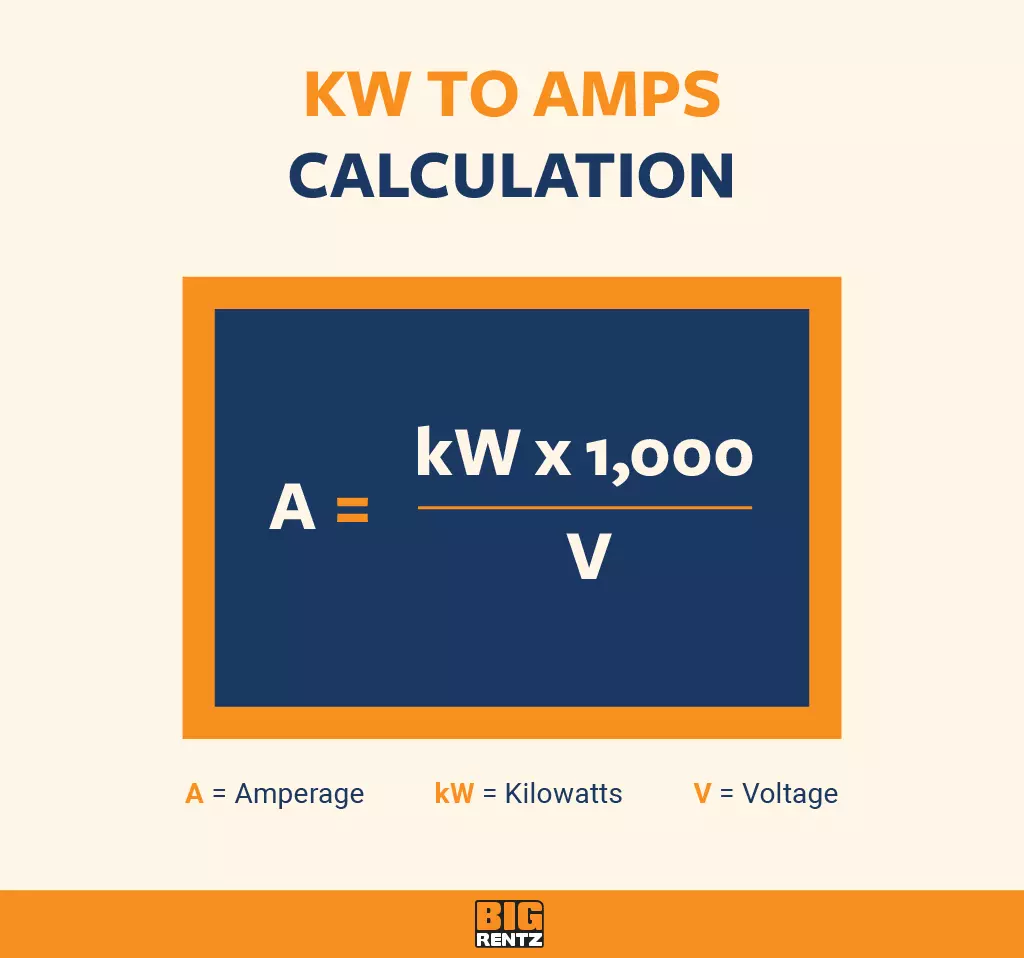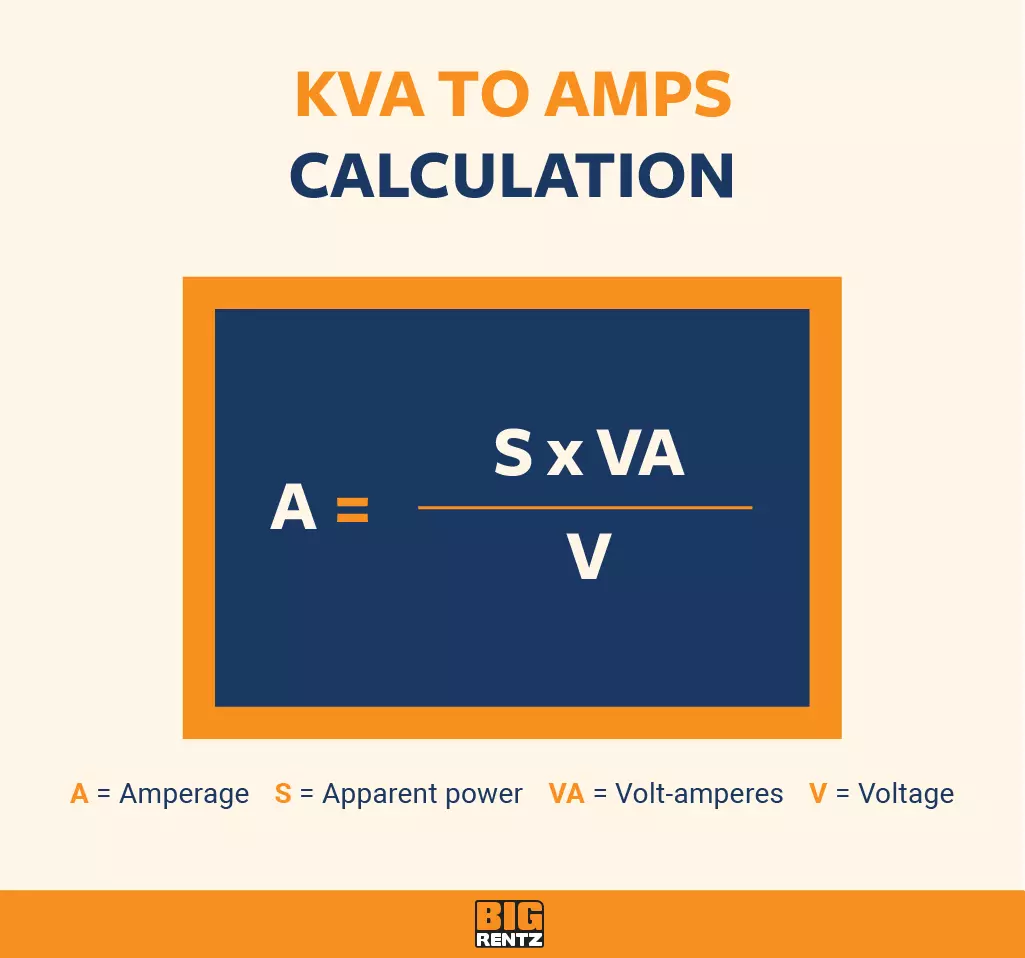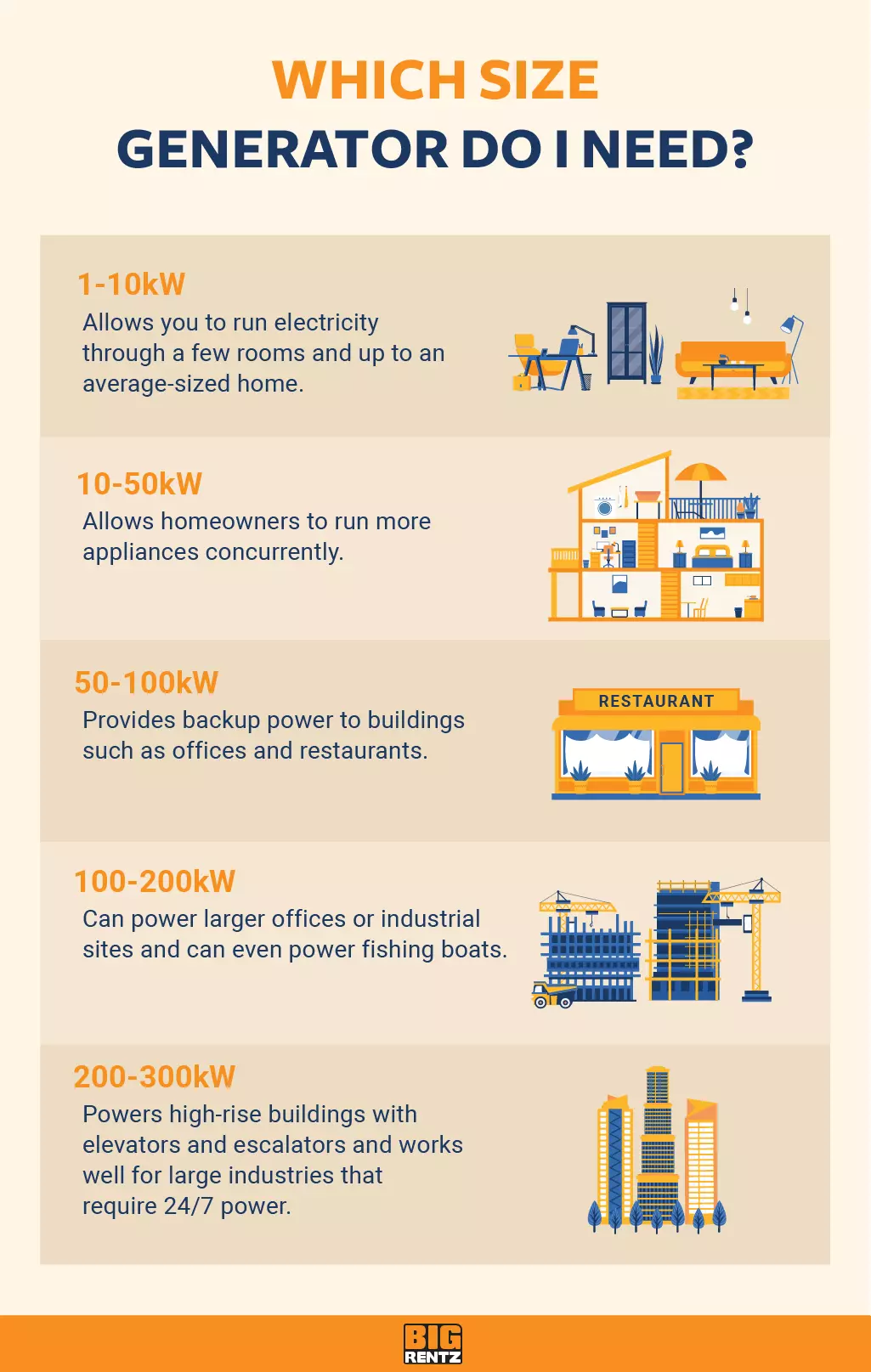Using your generator’s operating power and voltage, you can consult the chart below to estimate the output amperage of a generator. This chart provides only an estimate of how many amps your generator produces while it’s operating, and does not constitute an exact representation; various factors can raise or lower the value.
Explore All Generators
Amperage Conversion Chart
80% power factor
| kVA | kW | 208 V | 220 V | 240 V | 380 V | 400 V | 440 V | 450 V | 480 V | 600 V | 2400 V | 3300 V | 4160 V |
| 8 | 6.3 | 17.5 | 16.5 | 15.2 | 9.6 | 9.1 | 8.3 | 8.1 | 7.6 | 6.1 | — | — | — |
| 9.4 | 7.5 | 26.1 | 24.7 | 22.6 | 14.3 | 13.6 | 12.3 | 12 | 11.3 | 9.1 | — | — | — |
| 12.5 | 10 | 34.7 | 33 | 30.1 | 19.2> | 18.2 | 16.6 | 16.2 | 15.1 | 12 | — | — | — |
| 18.7 | 15 | 52 | 49.5 | 45 | 28.2 | 27.3 | 24.9 | 24.4 | 22.5 | 18 | — | — | — |
| 25 | 20 | 69.5 | 66 | 60.2 | 38.4 | 36.4 | 33.2 | 30.1 | 24 | 6 | 4.4 | 3.5 | — |
| 31.3 | 25 | 87 | 82.5 | 75.5 | 48 | 45.5 | 41.5 | 40.5 | 37.8 | 30 | 7.5 | 5.5 | 4.4 |
| 37.5 | 30 | 104 | 99 | 90.3 | 57.6 | 54.6 | 49.8 | 48.7 | 45.2 | 36 | 9.1 | 6.6 | 5.2 |
| 50 | 40 | 139 | 132 | 120 | 77 | 73 | 66.5 | 65 | 60 | 48 | 12.1 | 8.8 | 7 |
| 62.5 | 50 | 173 | 165 | 152 | 96 | 91 | 83 | 81 | 76 | 61 | 15.1 | 10.9 | 8.7 |
| 75 | 60 | 208 | 198 | 181 | 115 | 109 | 99.6 | 97.5 | 91 | 72 | 18.1 | 13.1 | 8.7 |
| 93.8 | 75 | 261 | 247 | 226 | 143 | 136 | 123 | 120 | 113 | 90 | 22.6 | 16.4 | 13 |
| 100 | 80 | 278 | 264 | 240 | 154 | 146 | 133 | 130 | 120 | 96 | 21.1 | 17.6 | 13.9 |
| 125 | 100 | 347 | 330 | 301 | 192 | 182 | 166 | 162 | 150 | 120 | 30 | 21.8 | 17.5 |
| 156 | 125 | 433 | 413 | 375 | 240 | 228 | 208 | 204 | 188 | 150 | 38 | 27.3 | 22 |
| 187 | 150 | 520 | 495 | 450 | 288 | 273 | 249 | 244 | 225 | 180 | 45 | 33 | 26 |
| 219 | 175 | 608 | 577 | 527 | 335 | 318 | 289 | 283 | 264 | 211 | 53 | 38 | 31 |
| 250 | 200 | 694 | 660 | 601 | 384 | 364 | 332 | 324 | 301 | 241 | 60 | 44 | 35 |
| 312 | 250 | 866 | 825 | 751 | 480 | 455 | 415 | 405 | 376 | 300 | 75 | 55 | 43 |
| 375 | 300 | 1040 | 990 | 903 | 576 | 546 | 498 | 487 | 451 | 361 | 90 | 66 | 52 |
| 438 | 350 | 1220 | 1155 | 1053 | 672 | 637 | 581 | 568 | 527 | 422 | 105 | 77 | 61 |
| 500 | 400 | 1390 | 1320 | 1203 | 770 | 730 | 665 | 650 | 602 | 481 | 120 | 88 | 69 |
| 625 | 500 | 1735 | 1650 | 1504 | 960 | 910 | 830 | 810 | 752 | 602 | 150 | 109 | 87 |
| 750 | 600 | 2080 | 1980 | 1803 | 1150 | 1090 | 996 | 975 | 902 | 721 | 180 | 131 | 104 |
| 875 | 700 | 2430 | 2310 | 2104 | 1344 | 1274 | 1162 | 1136 | 1052 | 842 | 210 | 153 | 121 |
| 1000 | 800 | 2780 | 2640 | 2405 | 1540 | 1460 | 1330 | 1300 | 1203 | 962 | 241 | 176 | 139 |
| 1125 | 900 | 3120 | 2970 | 2709 | 1730 | 1640 | 1495 | 1460 | 1354 | 1082 | 271 | 197 | 156 |
| 1250 | 1000 | 3470 | 3300 | 3009 | 1920 | 1820 | 1660 | 1620 | 1504 | 1202 | 301 | 218 | 174 |
| 1563 | 1250 | 4350 | 4130 | 3765 | 2400 | 2280 | 2080 | 2040 | 1805 | 1503 | 376 | 273 | 218 |
| 1875 | 1500 | 5205 | 4950 | 4520 | 2800 | 2730 | 2490 | 2440 | 2260 | 1805 | 452 | 327 | 261 |
| 2188 | 1750 | — | — | 5280 | 3350 | 3180 | 2890 | 2830 | 2640 | 2106 | 528 | 380 | 304 |
| 2500 | 2000 | — | — | 6020 | 3840 | 3640 | 3320 | 3240 | 3015 | 2405 | 602 | 436 | 348 |
| 2812 | 2250 | — | — | 6780 | 4320 | 4095 | 3735 | 3645 | 3400 | 2710 | 678 | 491 | 392 |
| 3130 | 2500 | — | — | 7520 | 4800 | 4560 | 4160 | 4080 | 3765 | 3005 | 752 | 546 | 435 |
In simplest terms, kW is the amount of power a device generates, while kVA is the amount of current it uses.
- Kilowatts (kW): Under the metric system, a kilowatt is the equivalent of 1,000 watts. It’s the amount of actual power that a machine such as an engine or gas generator produces.
- Kilovolt-ampere (kVA): This measurement is more widely used outside the United States. It reflects the apparent power generated: the amount of power being used by the system.
In a direct current or DC system, the two numbers are the same. But in alternating current or AC systems, the current can get out of phase with the voltage, making the system less efficient. In such cases, you’ll be using less power than you’re putting out.
If your electrical system isn’t wired to carry the amount of current you’re generating, you’ll be wasting power.
Phase Amperes Explained
Generators (sometimes called gensets, for “generator sets”) come in two types: single-phase and three-phase machines.
Single-phase AC generators are typically used when you don’t need as much power and you don’t need a generator that runs continuously. They operate in a general range of 120 to 240 volts (at the low end of the chart shown above). They’re good for residential use, so if you need a generator for your home, they can provide efficiency and power economically.
- To calculate the generator kVA for a single-phase current, multiply volts x amps and divide by 1,000.
- To calculate kW, multiply volts x amps x the power factor (PF) — the ratio of actual power flowing to apparent power — then divide by 1,000.
Three-phase currents also supply AC power and operate at a much higher voltage, typically around 480 volts. Unlike single-phase generators, they supply power in three waves, so their output is continuous. These commercial generators are used primarily for heavy-duty jobs, such as powering industrial and agricultural projects and operations.
- To calculate the kVA for a three-phase generator, multiply volts x amps x 1.73, then divide the result by 1,000.
- To calculate kW, multiply volts x amps x 1.73 x PF — the ratio of actual power flowing to apparent power — then divide by 1,000.
Calculating Generator Output
What size generator do you need? That’s an important question. Whether you’re buying or renting a generator, knowing its output tells you if it can supply enough power to run what you plan to operate. If you’re using a generator for your home, you’ll typically need to operate several things at once: a refrigerator, for example, along with an electric heater or air conditioner, plus things you might use periodically, such as a television or microwave.
If you’re using a generator at a construction site, you might want it to power a router, soldering iron, circular saw, electric drill, and air compressor. Whether you’re using a generator at home or at an industrial site, you’ll need to know how much a generator can power.
You’ll also need to take into account that some devices take more wattage to start than they do once they’re up and running. So you’ll want to calculate the maximum output you’ll need by including those higher figures.

kW to Amps Calculation
In addition to knowing wattage, you’ll want to know amperage. Watts are a measure of how much power is produced. Amps tell you how much power (current) is moving through the wires. Wires can only carry so much current, depending on their size; the bigger they are, the more amps they can accommodate.
So when you choose wiring for electrical appliances, it’s important to match the amp capacity to the wattage. To convert watts to amps based on DC kilowatts, simply multiply kW x 1,000, then divide the result by the number of volts.
A = kW x 1,000
V
In a single-phase AC system, amperage can be determined by multiplying kW x 1,000, then dividing the resulting figure by the result of volts x PF.
A = kW x 1,000
(PF x V)
The equation for a three-phase AC system is a little more complicated. In this system, you can calculate amperage by multiplying your real power in Kw (P) x 1,000 to get your numerator. Then, you need to determine your denominator by multiplying PF x the square root of 3 x the difference in voltage between any two lines in the system, expressed as VL-L.
A = P x 1,000
(PF x √3 x VL-L)

kVA to Amps Calculation
Sometimes, you may be given a kVA value rather than kW and need to convert this to amps instead. In this case, you multiply the apparent power (S) by the number of volt-amperes (VA), then divide the result by the number of volts.
A = S x VA
V

Choosing the Right Size Generator
Generators come in different sizes with varying power capacities. Will you need a medium, large, extra-large, or industrial generator? Here’s how you can find out:
First, take an inventory of all the electrical appliances you want to power. Be sure to account for the fact that some will take more wattage to start than to run once they’re going.
Next, add up all the wattage required for every item on your list. Then go a little higher than the total — 10% is a good figure — to be sure you have enough power. (Give yourself some breathing room in case you’ve missed something or will want to add another appliance later on.) Here’s a breakdown of different-sized generators and what they’re good for.
- 1 kW to 10 kW — If the power goes out, how much do you need to keep operating? A portable 5 kW generator will allow you to run a refrigerator, four lights, a fan, and an electric motor. But for the average-sized home, you’ll probably want at least 10 kW of power. Most generators in this class run on natural gas, propane, or diesel fuel.
- 10 kW to 50 kW — Homeowners with more appliances that need to run concurrently may want a generator in this class. Maybe you’ve got heavy-energy-use appliances such as HVAC units, water pumps, and washing machines that need extra wattage, and plan to use them all at once. If so, you may want to consider a propane, diesel, or natural gas generator in this class.
- 50 kW to 100 kW — Typically diesel-powered, these are a good choice to provide backup power to offices and restaurants.
- 100 kW to 200 kW — If you’re operating a larger office or industrial site, this class of generator may suit you best. They take both diesel and gas, and can also power such things as fishing boats.
- 200 kW to 300 kW+ — Generators this powerful run on diesel or gas, and can power high-rise buildings equipped with elevators and/or escalators, as well as large industries. Industrial generators of this size are a good choice if you need to keep things running 24/7.
::backdrop{background:rgba(0,0,0,.65)}.cta–dialog[open]{border-width:0;display:flex;flex-direction:column;align-items:center;width:90%;max-width:37.5rem;padding:1.5rem}.cta–dialog[open] .dialog–close{position:absolute;top:1.25rem;right:1.5rem;font-size:30px;line-height:1}.cta–dialog[open] .dialog–header{font-size:1.5rem;font-weight:500;line-height:1.3;text-align:center;margin:1.5rem auto .5rem;padding:1.5rem 0 0}@media (min-width: 768px){.cta–dialog[open] .dialog–header{font-size:2rem;margin:0 0 .5rem;padding:0;text-align:left;width:80%}}.cta–dialog[open] .wrapper–form-illo{display:flex;flex-direction:column;align-items:center;width:100%}@media (min-width: 768px){.cta–dialog[open] .wrapper–form-illo{flex-direction:row;justify-content:center;column-gap:2rem}}.cta–dialog[open] svg{margin-top:.5rem;width:52%;max-width:11.5rem}@media (min-width: 768px){.cta–dialog[open] svg{margin-top:0;max-width:15rem}}@media (min-width: 768px){.cta–dialog[open]{align-items:flex-start}}

×
Download our FREE generator rental guide e-book today!
Once you’ve chosen your generator and have it up and running, you’ll want to make sure it’s properly maintained. With regular maintenance, a genset can last 20 years or more.
Explore All Generators